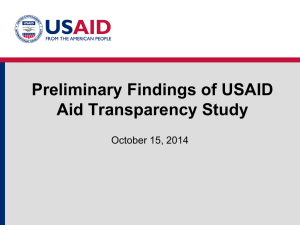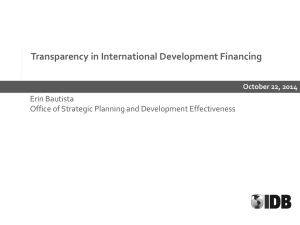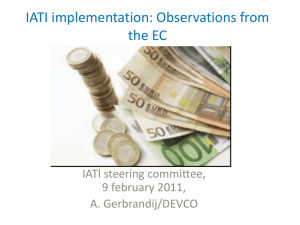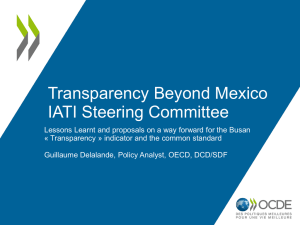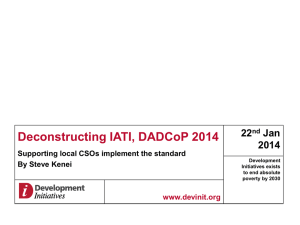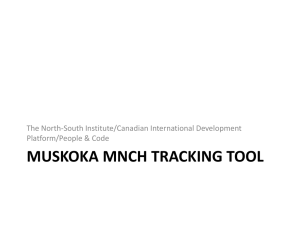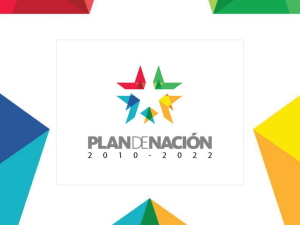Transparency and U.S. Foreign Assistance: a Year in Review
advertisement
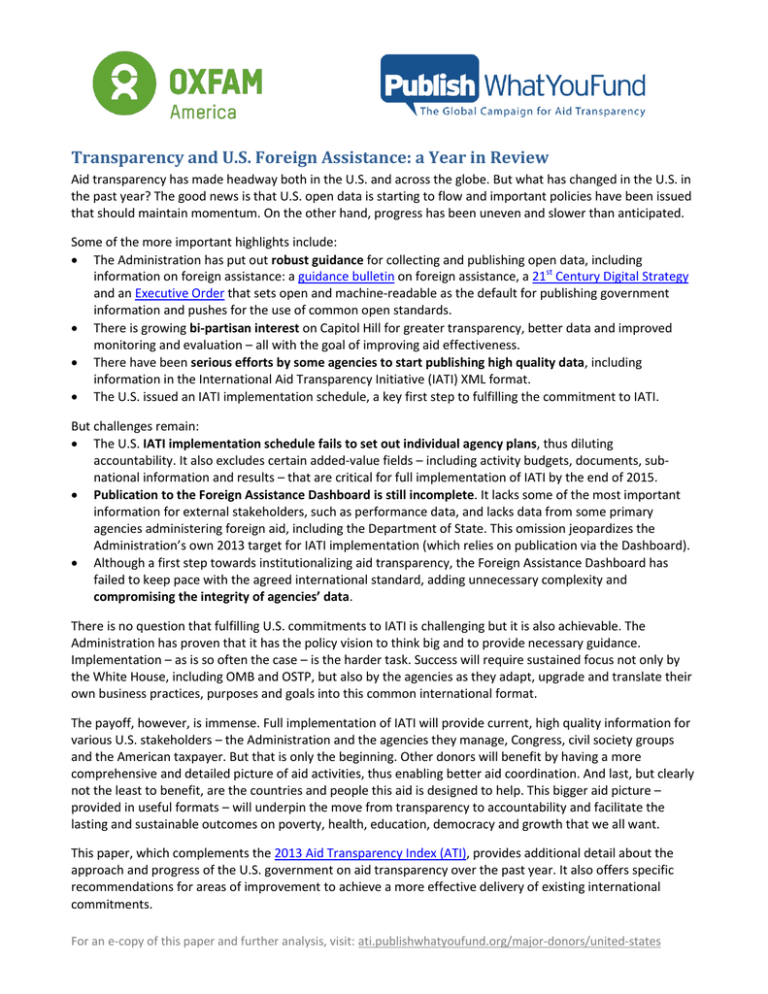
Transparency and U.S. Foreign Assistance: a Year in Review Aid transparency has made headway both in the U.S. and across the globe. But what has changed in the U.S. in the past year? The good news is that U.S. open data is starting to flow and important policies have been issued that should maintain momentum. On the other hand, progress has been uneven and slower than anticipated. Some of the more important highlights include: The Administration has put out robust guidance for collecting and publishing open data, including information on foreign assistance: a guidance bulletin on foreign assistance, a 21st Century Digital Strategy and an Executive Order that sets open and machine-readable as the default for publishing government information and pushes for the use of common open standards. There is growing bi-partisan interest on Capitol Hill for greater transparency, better data and improved monitoring and evaluation – all with the goal of improving aid effectiveness. There have been serious efforts by some agencies to start publishing high quality data, including information in the International Aid Transparency Initiative (IATI) XML format. The U.S. issued an IATI implementation schedule, a key first step to fulfilling the commitment to IATI. But challenges remain: The U.S. IATI implementation schedule fails to set out individual agency plans, thus diluting accountability. It also excludes certain added-value fields – including activity budgets, documents, subnational information and results – that are critical for full implementation of IATI by the end of 2015. Publication to the Foreign Assistance Dashboard is still incomplete. It lacks some of the most important information for external stakeholders, such as performance data, and lacks data from some primary agencies administering foreign aid, including the Department of State. This omission jeopardizes the Administration’s own 2013 target for IATI implementation (which relies on publication via the Dashboard). Although a first step towards institutionalizing aid transparency, the Foreign Assistance Dashboard has failed to keep pace with the agreed international standard, adding unnecessary complexity and compromising the integrity of agencies’ data. There is no question that fulfilling U.S. commitments to IATI is challenging but it is also achievable. The Administration has proven that it has the policy vision to think big and to provide necessary guidance. Implementation – as is so often the case – is the harder task. Success will require sustained focus not only by the White House, including OMB and OSTP, but also by the agencies as they adapt, upgrade and translate their own business practices, purposes and goals into this common international format. The payoff, however, is immense. Full implementation of IATI will provide current, high quality information for various U.S. stakeholders – the Administration and the agencies they manage, Congress, civil society groups and the American taxpayer. But that is only the beginning. Other donors will benefit by having a more comprehensive and detailed picture of aid activities, thus enabling better aid coordination. And last, but clearly not the least to benefit, are the countries and people this aid is designed to help. This bigger aid picture – provided in useful formats – will underpin the move from transparency to accountability and facilitate the lasting and sustainable outcomes on poverty, health, education, democracy and growth that we all want. This paper, which complements the 2013 Aid Transparency Index (ATI), provides additional detail about the approach and progress of the U.S. government on aid transparency over the past year. It also offers specific recommendations for areas of improvement to achieve a more effective delivery of existing international commitments. For an e-copy of this paper and further analysis, visit: ati.publishwhatyoufund.org/major-donors/united-states IATI and the role of the U.S. IATI has gained significant momentum. Following the G8 meetings this summer, donors accounting for 86% of Official Development Finance (ODF) have now committed to publishing their aid data to IATI. This strong political commitment is also translating into actual publication, with donors accounting for 69% of ODF publishing some information to the IATI Registry. Since the decision to join IATI, announced in Busan in 2011, the U.S. has significantly scaled up its involvement in the IATI process, both in terms of active attendance at the governing and technical meetings as well as in its support in terms of membership fees and a voluntary contribution. Such support and participation is to be commended. Due to its size and global leverage as a donor, full implementation of IATI by the U.S. is critical. In 2012 alone, the U.S. provided over $30 billion in Official Development Assistance (ODA)1, making it by far the largest bilateral donor. In some of the most aid dependent countries – Afghanistan, for example – U.S. foreign assistance makes up more than half of the total aid received. U.S. foreign assistance is a complex picture, with over 25 agencies responsible for its administration. Some of these agencies are largely domestic in their mission with responsibility for only a small sliver of aid, while others have a core foreign assistance focus with responsibility for significant resources. USAID, for example, spent over $16 billion in 2012.2 And PEPFAR is the largest international health initiative ever dedicated to a single disease, making its omission from both the Foreign Assistance Dashboard and IATI problematic.3 The internal coordination of foreign assistance resources within USG is a real challenge. But external coordination of aid – among donors, recipients and the many implementing partners and stakeholders in country – is even more challenging. A lack of timely, accessible, comparable and comprehensive aid information was the impetus behind the creation of IATI, which has become the critical tool to achieve this coordination. Getting the job done Since the release of the 2012 Index, the U.S. has made important progress, but substantial challenges remain if it is to meet its foreign assistance commitments by the end of 2015.4 The U.S. presented an implementation schedule in December 2012 that sets out its goals for publishing ODA flows from all departments and agencies that fund or execute activities. Instead of setting out an agency-byagency plan, however, it simply sets out percentage goals for the government as a whole (70% by 2013, 90% by 2014, and full implementation by 2015). This schedule, categorized as “unambitious” by Publish What You Fund’s assessment of all donor schedules, lacks the kind of accountability that is important to drive agency action. The schedule also excludes plans to publish to several of IATI’s “added-value” fields, such as activity budgets, documents, sub-national location, results and conditions, all of which are critical to the IATI standard. The Foreign Assistance Dashboard – conceived before the U.S. committed to IATI – is intended to be a “onestop shop” for foreign assistance information. Given the plethora of U.S. agencies involved in providing foreign assistance, this was a welcome initiative. However, as a platform for actually publishing agencies’ information to IATI, it has added unnecessary complexity to the process, particularly in the collecting and mapping of 1 OECD 2012 DAC http://stats.oecd.org/Index.aspx?DatasetCode=TABLE1 Foreign Assistance Dashboard, combined spent figure for USAID and DOS http://foreignassistance.gov/AgencyLanding.aspx 3 PEPFAR’s final funding level is $18bn: http://2006-2009.pepfar.gov/documents/organization/113878.pdf 4 Busan Outcome Document § 23 c) “We will agree on this standard and publish our respective schedules to implement it by December 2012, with the aim of implementing it fully by December 2015.” http://www.publishwhatyoufund.org/updates/news/aid-transparency-busan-outcome-document/ 2 For an e-copy of this paper and further analysis, visit: ati.publishwhatyoufund.org/major-donors/united-states 2 agencies’ information. The U.S. has chosen to create its own Dashboard standard rather than to adopt the agreed international standard. This means that information shared by the agencies goes through a complex process of manual “crosswalking” after it is shared with the Dashboard and prior to being shared with the IATI Registry: Agencies’ data is collected and shared with the Dashboard in an Excel spreadsheet. The Dashboard team converts the data collected into the Dashboard standard. The Dashboard crosswalks the data into the IATI standard and reports to IATI Registry. This process has compromised the integrity of agencies’ data. For example, some individual transactions have been aggregated into total amounts within a reporting period, rather than being kept separate, and financial data for subsidiary projects has been erroneously attached to “parent” programs.5 This would not occur if the Dashboard fully adopted the IATI XML schema.6 Specific, additional needs for U.S. reporting could be accommodated through “bolt-ons” to the IATI XML schema. The Dashboard does have an important role to play in terms of collecting data and presenting U.S. foreign assistance to a domestic audience. However, it is not well structured to produce IATI data. It should instead be the consumer of agencies’ IATI data. Almost three years since the creation of the Dashboard, it still remains largely incomplete. The majority of the data published does not include transactions and it is not linked to performance data – some of the most important information to recipients. There are only a handful of agencies publishing to the Dashboard, and the absence of any new information from some – like the State Department – puts the U.S. at significant risk of missing its 2013 implementation target. Results from the 2013 Aid Transparency Index (ATI) The ATI is an annual measure of the transparency of the world’s major donors. This year it assesses 67 donors worldwide, including five U.S. agencies and a major U.S. initiative (PEPFAR). The 2013 ATI improved its methodology through better assessment of the quality of published data – including taking the format of data into account. Data in the IATI XML format was scored most highly because it is both machine-readable and internationally comparable. Table 1: U.S. performance in the 2013 ATI Overall % Index Performance score overall category rank (out of 67) 88.9 1 Very Good MCC 47.4 19 Fair Treasury 44.3 22 Fair USAID 33.7 27 Poor Defense 22.1 40 Poor State 16.1 50 Very Poor PEPFAR Indicators the agency scores on (out of 39) 39 27 30 24 19 19 No of indicators published in IATI XML (out of 36)7 34 17 14 9 1 0 5 This is primarily because the Dashboard is currently unable to capture and display “hierarchies” of data – i.e. in cases where agencies run programs with several subordinate projects. 6 Use of the IATI XML schema by the Dashboard would potentially reduce the risks involved in data manipulation by third parties and would greatly reduce the current burdens of converting agencies’ data manually from spreadsheets. (See more on why good data matters here.) 7 See ati.publishwhatyoufund.org/approach/indicators for a detailed explanation of 2013 ATI indicators. For an e-copy of this paper and further analysis, visit: ati.publishwhatyoufund.org/major-donors/united-states 3 For the first time since the ATI was developed, a U.S. agency takes the first spot in the overall ranking. MCC should be particularly commended not only for the quality of its information but also for the coverage of its data, which includes all current compacts and thresholds and also includes fields not included in the U.S. implementation schedule. USAID and the Treasury Department have also shown significant improvements in their transparency since 2012. Overall, however, the quality of U.S. agencies’ data varies significantly – both in terms of the coverage of agencies’ spending and in the detail of the information presented. Key developments since the 2012 ATI that affected U.S. agencies’ performance in 2013 are as follows: The U.S. began publishing to IATI in January 2013 with information from MCC and USAID. In May 2013, data was added for Treasury Department and the Department of Defense. USAID made a significant step in July 2013 by publishing over 50,000 financial records. However, the information is currently not linked to USAID’s projects, performance information or the agency’s sectors and objectives. Linkage (particularly of financial and performance data) is important as it allows the user to understand the purpose of the investment. Also in July, MCC and Treasury (its Office for Technical Assistance) published in IATI XML their complete portfolios of current projects on their own websites. Their efforts and the high quality data published meant MCC and Treasury are the two highest ranking U.S. agencies in the 2013 ATI. Although a large amount of information on foreign assistance is published by U.S. agencies, much of it is still produced in PDFs or other non-machine-readable formats. Format is important as it affects the ability of stakeholders to use, reuse and visualize the data. Until information is published in a common and accessible format, recipients will continue to struggle to make use of the information. Recommendations to the U.S. Be ambitious. High quality and detailed data is critical to serve the needs of information users within and outside the government. Application of the entire IATI standard – including its added-value fields such as results and documentation – will help to deliver the Administration’s vision. Leadership from the White House will be essential. Use of this information should be promoted, both by the agencies and other potential users (e.g., recipients, legislators, researchers). The publishing agency itself should be a consumer of its own data – it should, for example, be used widely by country missions and implementers of agencies’ programs. Be more open about implementation. In order to increase clarity on how the U.S. plans to meet its aid transparency commitments, the U.S. should update its implementation schedule by mid-2014. This is not a rote exercise – it helps agencies to set delivery targets and specific dates against which they will be held accountable both by their own management and OMB. It also provides an opportunity to discuss priorities and approaches with data users. In addition to the broad recommendations above, there are specific, technical steps that would help the U.S. not only to deliver high quality aid information but also to meet its existing foreign assistance commitments: 1. The Dashboard should fully adopt the IATI XML schema and should follow the agreed structure and code lists of the IATI standard. The Dashboard can and should make any extensions or amendments needed to best accommodate U.S. foreign assistance information for other reporting requirements. 2. Agencies should consider upgrades to their financial and information management systems in order to produce comparable, comprehensive, timely and high quality aid information sustainably for all programs. This could involve building the IATI standard into agencies’ systems. 3. Departments or bureaus within agencies should be encouraged to publish their own information on their websites in IATI XML. In these cases, the Dashboard should publish their data to the IATI Registry without alterations. For an e-copy of this paper and further analysis, visit: ati.publishwhatyoufund.org/major-donors/united-states 4
